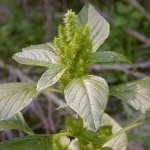| Common Name: |
Redroot |
| Other Names: |
New Jersey Tea |
| Botanical Name: |
Ceanothus americanus |
| Genus: |
Ceanothus |
| Family: |
Rhamnaceae |
| Location: |
Eastern C and SE United States, and S Canada |
| Cultivation: |
Well-drained soil in sun. Dislikes alkaline conditions but tolerates poor, dry soils. Cut back to within 8-10cm (3-4in) of the previous season's growth in spring. Scale insects may attack stems. Dislikes disturbance. |
| Propagation: |
By seed sown in autumn; by semi-ripe cuttings in summer. |
| Harvest: |
Roots are harvested from mid-summer to mid-winter, and dried for use in decoctions, liquid extracts, and tinctures. Leaves are gathered during the flowering period and dried. |
| Height: |
1m (3ft) |
| :Width |
45cm (18in) |
| Hardiness: |
Z4-8 |
| Parts Used: |
Roots |
| Properties: |
A bitter, astringent, cleansing herb that is expectorant, relaxes spasms, and has a tonic effect on the circulatory and lymphatic systems. |
| Medicinal Uses: |
Internally for colds, bronchitis, whooping cough, tonsilitis, diphtheria, sinusitis, enlarged spleen, abnormal uterine bleeding, nosebleeds, hemorrhoids, and depression. Contraindicated during pregnancy, and when suffering from blood disorders or taking medications that effect blood clotting. |
| Culinary Uses: |
Leaves are used as a caffiene-free tea substitute. |
| Bibliography: |
Encylopedia of Herbs by Deni Brown Copyright ©: 1995, 2001 Dorling Kindersley Limited pp.159-160
|

